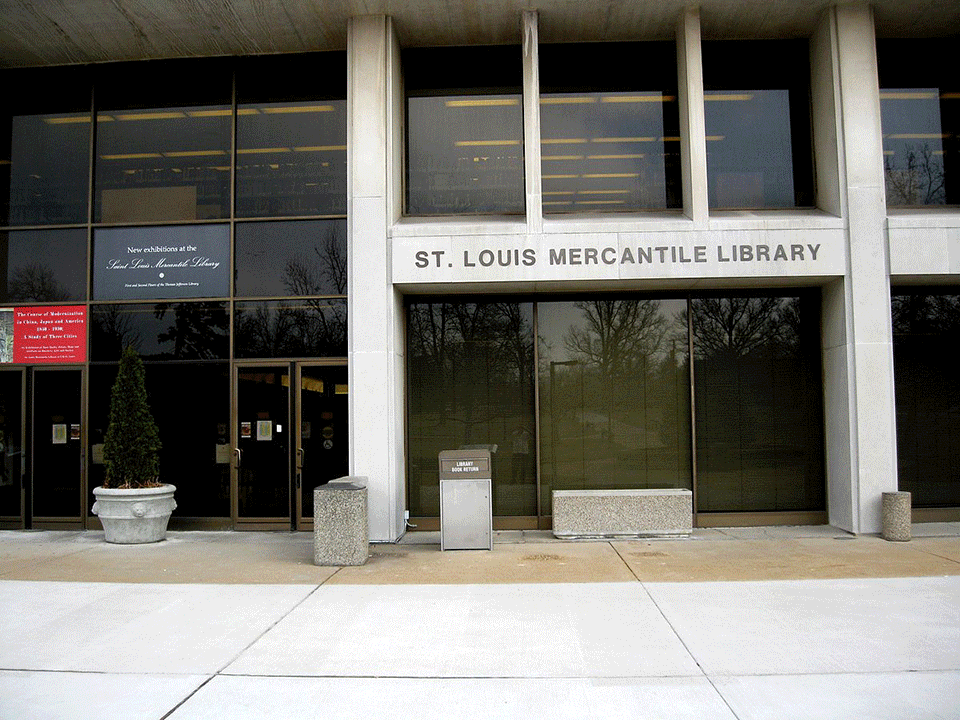A Nation: A City, & Its First Library: the St. Louis Mercantile Library
- by Bruce E. McKinney

Libraries represent bundles of ambitions, many initially modest, always beginning with the hope to make a difference in people’s lives. This is why tens of thousands of volunteers commit their time and imaginations to make their community institutions significant. While there are over 200,000 libraries worldwide their scale of ambitions range from simply providing tables and chairs, and books on the shelves, all the way to building and preserving historic collections that convey the deeper stories that connect the past to the future we experience today.
There is no one best way to do this but, given the United States’ regions and complex history, significant perspectives can best be elaborated by major regional collecting institutions. St. Louis is fortunate to have one: the St. Louis Mercantile Library.
This year the Mercantile is celebrating 175 years of service to their community and region and recently released a large quarto [9” x 12”] 255 page full color history of the St. Louis region providing both the story of the library as well as a tour through the collections they have built over these many years. It turns out the Mercantile has been on a tear over 17 decades, determined to be a major repository of the primary sources and documents for the deep Midwest.
Collectors can particularly appreciate this story because they regularly experience the complex decision making involved in pursing material for their own collections and can only imagine the thousands of decisions that were necessary to build a major collecting institution. Collectors’ ambitions, more often than not, flame out after a decade or two. For an institution to collect over parts of 3 centuries has meant to stay committed through the Civil War, social upheaval, though World Wars, not to mention structural changes.
Beyond gifts, the principal sources were initially local offers from dealers and opportunities at auctions that in time opened into broader possibilities as regional communications and access increased. Success as a collecting institution then required higher standards of cataloguing leading into the modern structuring of library records.
Today they live in the emerging world of the 5G internet we experience that merges what we see, saw, heard and read into an information blur we absorb at the speed of light. To succeed over 175 years the potential to fail has been constant, even unrelenting. Such success is rare and must be appreciated. Congratulations! The future will be in your debt.
For the progress over the past 3 decades a significant share of the credit must accrue to John Neal Hoover, their Executive Director, as leader of the library during the current period as the very definition and concept of what an uber important collecting library can and should become has been transforming in the embrace of social media as Internet connectivity has broadened access and personalized the experience. Thirty years ago the gold standard for collecting libraries was to accumulate and secure the important rare materials. To that obligation today the leading libraries embrace the goals of sharing and interpreting in imaginative ways. If twenty years ago, the college major as librarian was a declining specialty, the possibilities of innovative librarianship today suggest the careers of innovative programmers for the leading libraries beckon.
To those trying to understand what the Mercantile provides it’s necessary to experience the many forms they provide; rare books, maps, newspapers, photographs, manuscripts, archives, oral histories and motion pictures to name some. To appreciate their range, their anniversary volume captures both the scale and spirit of the enterprise.
To experience this range the time-honored way has always been to come in person and, given that their collections are partially accessible electronically, you can approach the institution with a click. But that said, to feel the depth of the collections page by page the volume effectively provides sequenced examples that make the clear statement this library is in the full embrace of the newest technologies.
Whether a collector or a St. Louis partisan or simply interested to see what the future of the past looks like consider adding a copy of “A Nation, A City, & Its First Library” to your own library. It will alter your view.
If you would like to purchase one of the 500 copies of this remarkable story here’s a link –
https://www.umsl.edu/mercantile/membership-and-giving/gift-shop.html